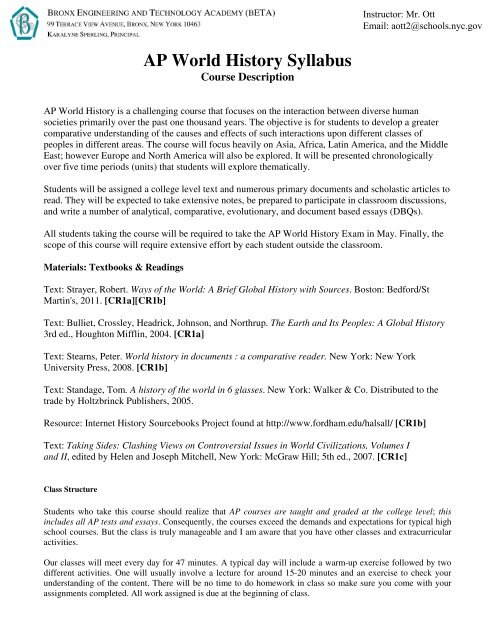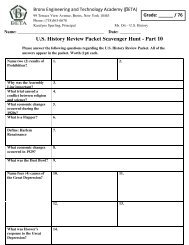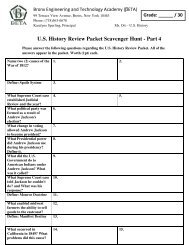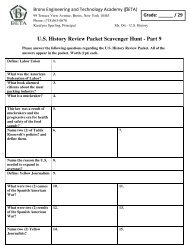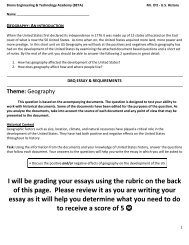AP World History Syllabus - BETA
AP World History Syllabus - BETA
AP World History Syllabus - BETA
- No tags were found...
Create successful ePaper yourself
Turn your PDF publications into a flip-book with our unique Google optimized e-Paper software.
<strong>AP</strong> <strong>World</strong> <strong>History</strong> <strong>Syllabus</strong>Course Description<strong>AP</strong> <strong>World</strong> <strong>History</strong> is a challenging course that focuses on the interaction between diverse humansocieties primarily over the past one thousand years. The objective is for students to develop a greatercomparative understanding of the causes and effects of such interactions upon different classes ofpeoples in different areas. The course will focus heavily on Asia, Africa, Latin America, and the MiddleEast; however Europe and North America will also be explored. It will be presented chronologicallyover five time periods (units) that students will explore thematically.Students will be assigned a college level text and numerous primary documents and scholastic articles toread. They will be expected to take extensive notes, be prepared to participate in classroom discussions,and write a number of analytical, comparative, evolutionary, and document based essays (DBQs).All students taking the course will be required to take the <strong>AP</strong> <strong>World</strong> <strong>History</strong> Exam in May. Finally, thescope of this course will require extensive effort by each student outside the classroom.Materials: Textbooks & ReadingsText: Strayer, Robert. Ways of the <strong>World</strong>: A Brief Global <strong>History</strong> with Sources. Boston: Bedford/StMartin's, 2011. [CR1a][CR1b]Text: Bulliet, Crossley, Headrick, Johnson, and Northrup. The Earth and Its Peoples: A Global <strong>History</strong>3rd ed., Houghton Mifflin, 2004. [CR1a]Text: Stearns, Peter. <strong>World</strong> history in documents : a comparative reader. New York: New YorkUniversity Press, 2008. [CR1b]Text: Standage, Tom. A history of the world in 6 glasses. New York: Walker & Co. Distributed to thetrade by Holtzbrinck Publishers, 2005.Resource: Internet <strong>History</strong> Sourcebooks Project found at http://www.fordham.edu/halsall/ [CR1b]Text: Taking Sides: Clashing Views on Controversial Issues in <strong>World</strong> Civilizations, Volumes Iand II, edited by Helen and Joseph Mitchell, New York: McGraw Hill; 5th ed., 2007. [CR1c]Class StructureStudents who take this course should realize that <strong>AP</strong> courses are taught and graded at the college level; thisincludes all <strong>AP</strong> tests and essays. Consequently, the courses exceed the demands and expectations for typical highschool courses. But the class is truly manageable and I am aware that you have other classes and extracurricularactivities.Our classes will meet every day for 47 minutes. A typical day will include a warm-up exercise followed by twodifferent activities. One will usually involve a lecture for around 15-20 minutes and an exercise to check yourunderstanding of the content. There will be no time to do homework in class so make sure you come with yourassignments completed. All work assigned is due at the beginning of class.
Grading1. 60% Grade Summativea. Timed (40 minutes to one hour) in-class essaysb. Unit Testsc. Notebook gradesd. Geography Testse. Mastery Checks and Quizzes2. 40% Grade Formativea. Daily Writing Exercisesb. Individual assignments including outlines* All grading will adhere to school grading policies regarding classwork, homework, and assessments.The Five Themes of <strong>AP</strong> <strong>World</strong> <strong>History</strong> [CR2]<strong>AP</strong> <strong>World</strong> <strong>History</strong> highlights five overarching themes that should receive approximately equal attentionthroughout the course beginning with the Foundations sections. The themes serve throughout the courseas unifying threads, helping students to put what is particular about each period or society into a largerframework.Theme 1- Interaction between humans and the environmentTheme 2- Development and Interaction of CulturesTheme 3- State-Building, expansion and interactions of Economic SystemsTheme 4- Creation, expansion and interactions of Economic SystemsTheme 5- Development and transformation of social structuresThe Four Historical Thinking Skills<strong>History</strong> is a sophisticated quest for meaning about the past, beyond the effort to collect information.Analysis of historical information requires awareness of names, chronology, facts and events. Devoid offactual and detailed information, historical thinking is not likely. The four Historical Thinking Skillslisted below provide a solid foundation for thinking historically.1. Crafting Historical Arguments from Historical Evidence2. Chronological Reasoning3. Comparison and Contextualization4. Historical Interpretation and SynthesisThemes [CR3]Period 1: Technological and Environmental Transformations, to c. 600 B.C.E.• Key Concept 1.1. Big Geography and the Peopling of the Earth• Key Concept 1.2. The Neolithic Revolution and Early Agricultural Societies• Key Concept 1.3. The Development and Interactions of Early Agricultural, Pastoral, and UrbanSocieties
Period 2: Organization and Reorganization of Human Societies, c. 600 B.C.E. to c. 600 C.E.• Key Concept 2.1. The Development and Codification of Religious and Cultural Traditions• Key Concept 2.2. The Development of States and Empires• Key Concept 2.3. Emergence of Transregional Networks of Communication and ExchangePeriod 3: Regional and Transregional Interactions, c. 600 C.E. to c. 1450• Key Concept 3.1. Expansion and Intensification of Communication and Exchange Networks• Key Concept 3.2. Continuity and Innovation of State Forms and Their Interactions• Key Concept 3.3. Increased Economic Productive Capacity and Its ConsequencesPeriod 4: Global Interactions, c. 1450 to c. 1750• Key Concept 4.1. Globalizing Networks of Communication and Exchange• Key Concept 4.2. New Forms of Social Organization and Modes of Production• Key Concept 4.3. State Consolidation and Imperial ExpansionPeriod 5: Industrialization and Global Integration, c. 1750 to c. 1900• Key Concept 5.1. Industrialization and Global Capitalism• Key Concept 5.2. Imperialism and Nation-State Formation• Key Concept 5.3. Nationalism, Revolution, and Reform• Key Concept 5.4. Global MigrationPeriod 6: Accelerating Global Change and Realignments, c. 1900 to the Present• Key Concept 6.1 Science and the Environment• Key Concept 6.2 Global Conflicts and Their ConsequencesWriting AssignmentsEach unit includes writing assignments designed to develop the skills necessary for creatingwell-evidenced essays on historical topics highlighting clarity and precision.Short Document Analysis: Students analyze three documents (one written, one visual andone quantitative) from the course primary source readers. For instance, in Unit 1, studentswill analyze sources for point of view, intended purpose, audience, and historical context ofeach source. These skills of primary source analysis will be applied throughout the course.Document Based Question (DBQ): Students analyze evidence from a variety of sourcesin order to develop a coherent written argument that has a thesis supported by relevanthistorical evidence. Students will apply multiple historical thinking skills as they examine aparticular historical problem or question. [CR6]Change and Continuity Over Time (CCOT): Students identify and analyze patterns ofcontinuity and change over time and across geographic regions. They will also connectthese historical developments to specific circumstances of time and place, and to broaderregional, national, or global processes. [CR10]Comparative Essay: Students compare historical developments across or within societiesin various chronological and/or geographical contexts. Students will also synthesizeinformation by connecting insights from one historical context to another, including thepresent. [CR14]
Text Timeline ReviewThe Text Timeline Review is an activity that will be completed by the end of each unit. Thereason for this activity is to address chronological thinking. According to the authors of theNational Standards for <strong>History</strong>, “chronological thinking is the heart of historical reasoning.”This activity requires students to use the chronological timeline of their textbook as a baselinefor the other primary and secondary source materials they encounter in their readings,research, and other studies. The students will place items from these other sources onto thetimeline associated with their textbook. Students will then be asked to write their responsesto the following prompts at the bottom of their timeline:1. What is the relationship between the causes and consequences of the events or processesidentified on the completed timeline? [CR9]2. Discuss the contradictions/inconsistencies between the textbook’s chronological timelineand that of the other sources. [CR11]Learning LogEach unit, the student will write a reflective commentary discussing how the history of the(identified) region or era fits into the larger story of world history. These commentaries shouldbe three to five paragraphs in length and will be submitted in the student notebook. This isnot a place to put your notes, but rather to think about what you really learned concerning“contextualization.” It also allows the student to continue to refine their abilities to developa written argument and analyze patterns of continuity and change over time. [CR13]Point/CounterpointStudents will use the Socratic seminar format in each unit to explore key controversies in world historyfrom ancient times to the present. The foundation for these conversations will be Taking Sides: ClashingViews on Controversial Issues in <strong>World</strong> Civilizations. This book examines issues that allow students toidentify and evaluate diverse historical interpretations by introducing students to controversies in worldcivilizations. This debate style reader contains readings representing the arguments of leading historiansand commentators on world history and reflects a variety of viewpoints presented in pro/con format. Allof the topics/questions listed in each unit for this activity come from this book. [CR7]Tag Team TeachingStudents will be divided into five or six groups each unit. These groups correspond to the <strong>AP</strong> <strong>World</strong><strong>History</strong> key concepts. The students will be given “workshop” days where they will be expected toconsult a variety of sources along with regular class texts. Students consider and analyze the differentthemes and periodizations that are contained in these sources and record their findings on Unit FocusSheets in categories mirroring the <strong>AP</strong> <strong>World</strong> <strong>History</strong> themes. Students will identify continuities fromprevious studies, as well as, the nature and causes of change as they apply to their assigned topic.Students will also evaluate multiple causes and consequences of the main historical developmentsrepresented in the textbooks. Using an inverted pyramid approach, students will prioritize their mostimportant information. The goal is to synthesize information into five listings per identified heading.Students will use this information to prepare a PowerPoint presentation for their classmates. Students arerequired to cite the information used on their slides and they must be able to answer questions andjustify their selections.
Artifact Posting AssignmentEach student will discover a historical artifact that they believe represents the unit and topic beingstudied. The teacher will set parameters each unit for these artifacts in order to ensure that studentsrecognize that the study of history has been shaped by the findings and methods of other disciplines(archeology, visual arts, geography, political science). They will then post an image of the artifact alongwith a discussion that identifies the artifact (who, what, when, where, why significant) and addresseswhat the artifact says (indicates, suggests) about politics, society or culture in the time and place it wasmade. Classmates will then use the elements of critical thinking to organize class discussion via theclassroom Internet <strong>AP</strong> <strong>World</strong> <strong>History</strong> Wiki. Each student in the class will be required to ask a questionabout the artifact that seeks to increase the clarity, accuracy and precision of the conversation. Thestudent posting the artifact must then answer the questions posed. Answering these questions mayrequire further research. Questions and answers should demonstrate that the respective authors puthonest thought into both the question and the answer. Throughout, students must cite the sources of theinformation provided. The initial artifact posts are due after the unit has been studied for one week.Classmates writing queries should post their questions from that point until the end of the unit. [CR15]Course OutlineUNIT ONE: Technological and Environmental TransformationsPERIODIZATION: c. 8000 BCE to c. 600 BCEMAIN FOCUS: Beginnings in <strong>History</strong>LENGTH OF CLASS TIME FOR UNIT: 6.5 DaysREADING TEXT: Ways of the <strong>World</strong>: A Global <strong>History</strong>. Chapters 1 – 3Key Concepts: [CR3]Key Concept 1.1: Big Geography and the Peopling of the EarthI. Paleolithic migrations lead to the spread of technology and cultureKey Concept 1.2: The Neolithic Revolution and Early Agricultural SocietiesI. Neolithic Revolution leads to new and more complex economic and social systemsII. Agricultural and pastoralism begins to transform human societyKey Concept 1.3: The Development and Interactions of Early Agricultural, Pastoral, and UrbanSocietiesI. Location of early foundational civilizationsII. State development and expansionIII. Cultural development in the early civilizationsUnit 1 Major Assignments:1. TEXT READING ASSIGNMENT: Ways of the <strong>World</strong>: A Global <strong>History</strong>. Chapters 1 – 32. WRITING ASSIGNMENTS: Students will begin preliminary work on how to write acomparative essay (life in high school). Hand out Essay Writing Packet and begin seriouswork on the comparative essay. Assign comparative essay regarding foraging andearly agricultural societies. [CR12]3. TEXT TIMELINE REVIEW: See Unit Activities explanation regarding this activity.
4. LEARNING LOG: Write a reflective commentary considering the role of human migrationduring this era and its connection to the larger story of world history. [CR4]5. SHORT PRIMARY SOURCE ANALYSIS: Teacher will model activity by having studentsanalyze the following textual, visual, and data sources: creation stories in the Rig Veda, Popul Vuh, andBible; Epic of Gilgamesh, the Egyptian Book of the Dead. The source analysis will include identifyingpoint of view, intended purpose, audience, and historical context of each source. [CR1b] & [CR8]6. POINT/COUNTERPOINT: Students will be introduced to the workings of Socratic Seminar. SeeUnit Activities explanation regarding this activity. Taking Sides topics: Did Homo Sapiens Originate inAfrica? Did Egyptian Civilization Originate in Africa? [CR4] & [CR5a]7. WORLD HISTORY ARTIFACT POSTING ASSIGNMENT: See Unit Activities explanationregarding this activity. Object must be connected to the field of archaeology, e.g. Neolithic Venusstatues or archaeological data from Jericho. Students will learn how to question the historical context ofsources and assess the reliability and validity of the information for specific historical questions. [CR1b]& [CR8]8. TAG TEAM TEACHING: Students will prepare to present this unit. They will be introduced to theHow Historians Work packet and activities (source, classification, value auction, cheating Bob, Vikings,shapes and memory, class history, garbageology, drawing conclusions, Bob Seger’s Revisionism Street);Teacher will review group presentation approach, requirements, and rubric. Teacher will also explainhow to use the themed unit focus sheets along with power point expectations. Students will practicepresentation skills by preparing presentations on Big <strong>History</strong>, Human Migration, Scythians, Indo-European languages, Semitic languages, Hunter-gatherers, Pastoralism, Neolithic Revolution,Metallurgy, Sumer, Nubia, Indus Valley Civilization, Zhou Dynasty, Olmec, Chavín culture, Sargon ofAkkad, Ziggurat, and other topics identified in the key concepts.UNIT ONE TEST: 70 multiple choice questions, In-class Compare/contrast essay.UNIT TWO: Organization and Reorganization of Human SocietiesPERIODIZATION: c. 600 BCE to c.600 CEMAIN FOCUS: The Classical Era in <strong>World</strong> <strong>History</strong>LENGTH OF CLASS TIME FOR UNIT: 18.5 daysREADING TEXT: Ways of the <strong>World</strong>: A Global <strong>History</strong>. Chapters 4 – 7Key Concepts: [CR3]Key Concept 2.1: The Development and Codification of Religious and Cultural TraditionsI. Codifications and further developments of existing religious traditionsII. Emergence, diffusion, and adaptation of new religious and cultural traditionsIII. Belief systems affect gender rolesIV. Other religious and cultural traditions continueV. Artistic expressions show distinctive cultural developmentsKey Concept 2.2: The Development of States and EmpiresI. Imperial societies grow dramaticallyII. Techniques of imperial administrationIII. Social and economic dimensions of imperial societiesIV. Decline, collapse, and transformation of empires (Rome, Han, Maurya)
Key Concept 2.3: Emergence of Trans-regional Networks of Communication and ExchangeI. The geography of trans-regional networks, communication and exchange networksII. Technologies of long-distance communication and exchangeIII. Consequences of long-distance tradeUnit 2 Major Assignments:1. TEXT READING ASSIGNMENT: Ways of the <strong>World</strong>: A Global <strong>History</strong>. Chapters 4 – 72. WRITING ASSIGNMENTS: Students will continue work on how to write a comparative essay.Possible prompts include: Compare the basic features of two classical civilizations: Mesoamerica, India,China, Greece, or Rome; Compare two of the following major religions or philosophical systems:Historical Vedic religions, Buddhism, Confucianism, Daoism, Judaism, Christianity, or Greco-Romanphilosophy; Compare the reasons for and the outcomes of the fall of two classical civilizations: Rome,Han China, and the Gupta. Students will also be introduced to the CCOT essay and rubric. [CR12][CR4], [CR5a], [CR5b], &[CR5e]3. TEXT TIMELINE REVIEW: See Unit Activities explanation regarding this activity.4. LEARNING LOG: Write a reflective commentary considering trans-regional networks ofcommunication and exchange and the consequences of long-distance trade during this era and itsconnection to the larger story of world history. [CR4]5. SHORT PRIMARY SOURCE ANALYSIS: The source analysis will include identifying point ofview, intended purpose, audience, and historical context of each source. Sources include descriptions oftravel or trade (Periplus of the Erythraean Sea or journeys of Faxian); Roman, Han, or Gupta coins;Leviticus, Twelve Tables, or The Analects6. POINT/COUNTERPOINT: Students will use skills introduced in Unit 1 regarding the SocraticSeminar. Taking Sides topics: Does Alexander the Great merit his exalted reputation? Did the benefitsof the First Emperor of China’s rule outweigh the human cost? Did Christianity liberate women? [CR4]& [CR5c]7. WORLD HISTORY ARTIFACT POSTING ASSIGNMENT: See Unit Activities explanationregarding this activity. Object must be connected to artistic expression (literature, architecture, orsculpture), e.g. examples of architecture in Mediterranean, Middle East, South Asia, East Asia, orMesoamerica; Greek sculpture, Buddhist art, or Moche art. Students will learn how to question thehistorical context of sources and assess the reliability and validity of the information for specifichistorical questions.8. TAG TEAM TEACHING: Students will present this unit. Student groups will research andmake presentations using the tools and guidelines established in Unit 1. Presentation groups will includeexplaining political and cultural developments in: Southwest Asia, East Asia, South Asia, Mediterraneanregion, Mesoamerica, and Andean South America. [CR5b]UNIT TWO TEST: 70 multiple choice questions, In-class essay on analyzing comparisons orchanges over time.
UNIT THREE: Regional and Transregional InteractionsPERIODIZATION: c. 600 CE-c.1450MAIN FOCUS: A Time of Accelerating ConnectionsLENGTH OF CLASS TIME FOR UNIT: 24 daysREADING TEXT: Ways of the <strong>World</strong>: A Global <strong>History</strong>. Chapters 8 – 13Key Concepts:Key Concept 3.1: Expansion and Intensification of Communication and Exchange NetworksI. Improved transportation technologies and commercial practices and their influence onnetworksII. Linguistic and environmental contexts for the movement of peoplesIII. Cross-cultural exchanges fostered by networks of trade and communicationIV. Continued diffusion of crops and pathogens throughout the Eastern HemisphereKey Concept 3.2: Continuity and Innovation in State Forms and Their InteractionsI. Empires collapse and were reconstitutedII. Greater inter-regional contacts and conflict encourages technology and cultural transferKey Concept 3.3: Increased Economic Productive Capacity and Its ConsequencesI. Increasing productive capacity in agriculture and industryII. Changes in urban demographyIII. Changes and continuities in labor systems and social structuresUnit 3 Major Assignments:1. TEXT READING ASSIGNMENT: Ways of the <strong>World</strong>: A Global <strong>History</strong>. Chapters 8 – 132. WRITING ASSIGNMENTS: Students will continue work on how to write essays that comparehistorical developments and assess the effects of changes over time. Possible prompts include questionsfrom previous released <strong>AP</strong> exams: Compare European and sub-Saharan African contacts with theIslamic world; Essay: Compare Aztec Empire and Inca Empire; Compare Japanese and Europeanfeudalism; Compare effects of Islam and Christianity on social systems and gender roles; Comparedevelopments in political and social institutions in both eastern and western Europe; Assess the effectsof the spread of Islam up to 1750; Students also will learn how to incorporate analysis of primarysources into their written arguments. Practice using the DBQ on the spread of Buddhism to China[CR5b], [CR5c] & [CR12]3. TEXT TIMELINE REVIEW: See Unit Activities explanation regarding this activity.4. LEARNING LOG: Write a reflective commentary considering the continued diffusion of flora, fauna,and pathogens throughout the Eastern Hemisphere during this era and its connection to the larger storyof world history using statistics on mortality rates from the fourteenth century bubonic plague pandemic.5. SHORT PRIMARY SOURCE ANALYSIS: The source analysis will include identifying point ofview, intended purpose, audience, and historical context of each source. Sources include excerpts fromthe travel books of Marco Polo and Ibn Battuta and the Secret <strong>History</strong> of the Mongols [CR1b] & [CR8]
6. POINT/COUNTERPOINT: Students will employ Socratic Seminar strategy. Taking Sides topics:Does the modern University have its roots in the Islamic <strong>World</strong>? Were environmental factorsresponsible for the collapse of Mayan civilization? Were the Crusades an early example of westernimperialism? Did women and men benefit equally from the Renaissance? [CR4] & [CR5b]7. WORLD HISTORY ARTIFACT POSTING ASSIGNMENT: See Unit Activities explanationregarding this activity. Object must be connected to political power, e.g. images from Rashid al-DinFadl Allah’s book on the Mongols or maps of Cairo, Baghdad, Delhi, and Florence.8. TAG TEAM TEACHING: Student groups will research and make presentations on: development ofpolitical institutions in the Islamic <strong>World</strong> (Abbasid Caliphate, Seljuq empire, sultanate of Delhi, MaliEmpire), Central Asia (Mongol Khanates), East Asia (Tang and Song dynasties), Latin West andByzantine Empire, Africa (Swahili city-states and Great Zimbabwe), South and Southeast Asia,Mesoamerica and the Andes; social and cultural effects of interactions due to the Crusades, Mongols,Hanseatic League, Bantu peoples, Vikings, Polynesians, and Bedouins; importance of travelerssuch as Marco Polo and Ibn Battuta; role of new cities such as Timbuktu, Tenochtitlan, or Cordoba;influence of new ideas and technologies: Neo-Confucianism, printing, gunpowder, and medicalresponses to the bubonic plague and other diseases [CR5a], [CR5b] [CR5c], [CR5d] & [CR5e]UNIT THREE TEST: 70 multiple choice questions, DBQ in-class essayUNIT FOUR: Global InteractionsPERIODIZATION: c. 1450 to c.1750MAIN FOCUS: The Early Modern <strong>World</strong>LENGTH OF CLASS TIME FOR UNIT: 24 daysREADING TEXT: Ways of the <strong>World</strong>: A Global <strong>History</strong>. Chapters 14 – 16KEY CONCEPTS: [CR3]Key Concept 4.1: Globalizing Networks of Communication and ExchangeI. Intensification of regional trade networks (Mediterranean, trans-Saharan, overland Eurasian,and Siberian trade routes)II. Trans-oceanic maritime reconnaissanceIII. New maritime commercial patternsIV. Technological developments enabling trans-oceanic tradeV. Environmental exchange and demographic trends: Columbian ExchangeVI. Spread and reform of religionVII. Global and regional networks and the development of new forms of art and expressionKey Concept 4.2: New Forms of Social Organization and Modes of ProductionI. Labor systems and their transformationsII. Changes and continuities in social hierarchies and identitiesKey Concept 4.3: State Consolidation and Imperial ExpansionI. Techniques of state consolidationII. Imperial expansionIII. Competition and conflict among and within States
Unit 4 Major Assignments:1. TEXT READING ASSIGNMENT: Ways of the <strong>World</strong>: A Global <strong>History</strong>. Chapters 14 – 162. WRITING ASSIGNMENTS: Students will continue work on how to write essays. Possibleprompts include questions from previous released <strong>AP</strong> exams: Compare coercive labor systems: slaveryand other coercive labor systems in the Americas; economic and social effects of the ColumbianExchange; DBQ on the Global flow of silver; Analyze imperial systems: European monarchy comparedwith a land-based Asian empire (China or Japan); Compare Russia’s interaction with the West with theinteraction of the West and one of the following: Ottoman Empire, China, Tokugawa Japan, MughalIndia [CR12]3. TEXT TIMELINE REVIEW: See Unit Activities explanation regarding this activity.4. LEARNING LOG: Write a reflective commentary considering the impact of the Columbian Exchangeduring this era and its connection to the larger story of world history.5. SHORT PRIMARY SOURCE ANALYSIS: The source analysis will include identifying point ofview, intended purpose, audience, and historical context of each source. Sources include: Ma Huan, DeLas Casas, Codex Mendosa, Letters from the King of Kongo [CR1b] & [CR8]6. POINT/COUNTERPOINT: Students will employ Socratic Seminar strategy. Taking Sides topics:Should Christopher Columbus be considered a hero? Did Tokugawa policies strengthen Japan? DidOliver Cromwell advance political freedom in seventeenth-century Europe? Did Indian EmperorAurangzeb’s rule mark the beginning of Mughal decline? Did Peter the Great exert a positive influenceon the development of Europe?7. WORLD HISTORY ARTIFACT POSTING ASSIGNMENT: See Unit Activities explanationregarding this activity. Object must be connected to Trans-oceanic trade e.g. images of caravels, dhows,Ming Treasure Ship fleet, Polynesian outrigger canoes, and tools used to facilitate the trade (coins,maps, compasses, astrolabes, and sails) [CR1b] & [CR8]8. TAG TEAM TEACHING: Student groups will research and make presentations. Presentation groupswill be responsible for explaining: the political and cultural developments in Spain, Portugal, France,England, Holland, Russia, Ottoman Empire, Ming and Qing China, Tokugawa Japan, Mughal Empire,West and East African polities, Safavid Empire, Aztec and Incan empires; economic effects of codfisheries, mercantilism, astrolabe, caravels, Columbian Exchange, and new labor systems(encomienda, indentured servitude, janissaries, chattel slavery in the Americas) [CR5a], [CR5b] [CR5c],[CR5d], [CR5e], & [CR4]UNIT FOUR TEST: 70 multiple choice questions, in-class essay drawn from either the pastCompare/Contrast, CCOT, or DBQ formats.UNIT FIVE: Industrialization and Global IntegrationPERIODIZATION: c. 1750 to c. 1900MAIN FOCUS: The European Moment in <strong>World</strong> <strong>History</strong>LENGTH OF CLASS TIME FOR UNIT: 24 daysREADING TEXT: Ways of the <strong>World</strong>: A Global <strong>History</strong>. Chapters 17 – 20
Key Concepts: [CR3]Key Concept 5.1: Industrialization and Global CapitalismI. IndustrializationII. New patterns of global trade and productionIII. Transformation of capital and financeIV. Revolutions in transportation and communication: Railroads, steamships, canals,telegraphV. Reactions to the spread of global capitalismVI. Social transformations in industrialized societiesKey Concept 5.2: Imperialism and Nation-State FormationI. Imperialism and colonialism of trans-oceanic empires by industrializing powersII. State formation and territorial expansion and contractionIII. Ideologies and imperialismKey Concept 5.3: Nationalism, Revolution, and ReformI. The rise and diffusion of Enlightenment thoughtII. 18th century peoples develop a sense of commonalityIII. Spread of Enlightenment ideas propels reformist and revolutionary movementsIV. Enlightenment ideas spark new transnational ideologies and solidaritiesKey Concept 5.4: Global MigrationI. Demography and urbanizationII. Migration and its motivesIII. Consequences of and reactions to migrationUnit 5 Major Assignments:1. TEXT READING ASSIGNMENT: Ways of the <strong>World</strong>: A Global <strong>History</strong>. Chapters 17 – 202. WRITING ASSIGNMENTS: Students will continue work on how to write essays. Possible promptsinclude questions from previous released <strong>AP</strong> exams: DBQ- Indentured servitude; Development ofGlobal trade patterns, 1750-1914; Compare the French and Haitian Revolutions; Compare reaction toforeign domination in the Ottoman Empire, China, India, and Japan; Compare nationalism, e.g., Chinaand Japan, Cuba and the Philippines, Egypt and Nigeria; Compare forms of Western intervention inLatin America and in Africa; Compare the roles and conditions of women in the upper/middle classeswith peasantry working class in Western Europe; Compare the causes and social impact of the IndustrialRevolution in Western Europe and Japan [CR12]3. TEXT TIMELINE REVIEW: See Unit Activities explanation regarding this activity.4. LEARNING LOG: Write a reflective commentary considering the roots and influences ofEnlightenment thought during this era and its connection to the larger story of world history. [CR4]5. SHORT PRIMARY SOURCE ANALYSIS: The source analysis will include identifying pointof view, intended purpose, audience, and historical context of each source. Sources might includeexcerpts from: Locke, Montesquieu, Declaration of Independence, Declaration of the Rights of Man andCitizen, Jamaica Letter, Adam Smith, and Karl Marx; statistics about bonded labor migrations from Asiato the Americas and Africa. [CR1b] & [CR8]
6. POINT/COUNTERPOINT: Students will employ Socratic Seminar strategy. Taking Sides topics: Didthe West define the modern world? Was the French Revolution worth its human costs? Did the MeijiRevolution Constitute a revolution in nineteenth-century Japan? Were Confucian values responsible forChina’s failure to modernize? [CR4]7. WORLD HISTORY ARTIFACT POSTING ASSIGNMENT: See Unit Activities explanationregarding this activity. Object must be connected to industrialization e.g. images of factories in England,USA, France, and Japan showing the size of the steam-powered machines and women working in thefactories; images of industrial cities with air or water pollution; political cartoons about Americanimperialism related to the Spanish-American war that affected Cuba, Puerto Rico, the Philippines, andGuam.8. TAG TEAM TEACHING: Student groups will research and make presentations. Presentation groupswill be responsible for the following topics: Seven Years’ War, Napoleonic Wars, Great Game inCentral Asia, Berlin Conference, Opium Wars, Zulu, Formation of Hawaii, German and ItalianUnification, Meiji restoration, Abolition, Marxism, Indian National Congress, Industrialization;Migration Suffrage, Scientific Revolution, Atlantic revolutions, Latin America Independencemovements, Boxer Rebellion, Indian Revolt of 1857, Taiping rebellion, Wahhabi Movement, Tanzimat,Self-Strengthening movement, Liberalism, Socialism, Communism, Anarchism, pan-Slavism,pan-Islamism, Factory System, and Second Industrial revolution [CR4]UNIT FIVE TEST: 70 multiple choice questions, in-class essay drawn from either the pastCompare/Contrast, CCOT, or DBQ formats.UNIT SIX: Accelerating Global Change and RealignmentsPERIODIZATION: c. 1900 to the presentMAIN FOCUS: The most recent centuryLENGTH OF CLASS TIME FOR UNIT: 24 daysREADING TEXT: Ways of the <strong>World</strong>: A Global <strong>History</strong>. Chapters 21 – 24Key Concepts: [CR3]Key Concept 6.1: Science and the EnvironmentI. Rapid advances in science spread assisted by new technologyII. Humans change their relationship with the environmentIII. Disease, scientific innovations, and conflict led to demographic shiftsKey Concept 6.2: Global Conflicts and Their ConsequencesI. Europe’s domination gives way to new forms of political organizationII. Emerging ideologies of anti-imperialism contribute to dissolution of empiresIII. Political changes accompanied by demographic and social consequencesIV. Military conflicts escalateV. Individual and groups oppose, as well as, intensify the conflictKey Concept 6.3: New Conceptualizations of Global Economy, Society, and CultureI. States, communities and individuals become increasingly interdependentII. People conceptualize society and culture in new waysIII. Popular and consumer culture become global
Unit 6 Major Assignments:1. TEXT READING ASSIGNMENT: Ways of the <strong>World</strong>: A Global <strong>History</strong>. Chapters 21 – 242. WRITING ASSIGNMENTS: Students will continue work on how to write essays. Possible promptsinclude questions from previous released <strong>AP</strong> exams: Compare the notion of the “East” and the “West” inCold War ideology; DBQ- Muslim Nationalist Movements; Choose two revolutions (Russian, Chinese,Cuban, Iranian) and compare their effects on the roles of women; Compare the causes and effects of the<strong>World</strong> Wars on areas outside of Europe; Compare legacies of colonialism and patterns of economicdevelopment in two of the following regions: Asia, Latin America, Africa; Compare patterns and resultsof decolonization in Africa and India [CR5b], [CR5c] & [CR5e]3. TEXT TIMELINE REVIEW: See Unit Activities explanation regarding this activity.4. LEARNING LOG: Write a reflective commentary considering social movements duringthis era and its connection to the larger story of world history. [CR4]5. SHORT PRIMARY SOURCE ANALYSIS: The source analysis will include identifying pointof view, intended purpose, audience, and historical context of each source. Sources might includeexcerpts from Gandhi, Nkrumah, and Ho Chi Min; data on the growth of outsourcing and businesscycles of multinational corporations in the twentieth and twenty first centuries [CR1b] & [CR8]6. POINT/COUNTERPOINT: Students will employ Socratic Seminar strategy. Taking Sidestopics: Did the Bolshevik Revolution improve the lives of Soviet women? Was Stalin responsible for theCold War? Does Islam revivalism challenge a secular world order? Should Africa’s leaders be blamedfor the continent’s current problems? Were ethnic leaders responsible for the disintegration ofYugoslavia? Will the Oslo Peace Accords benefit both Israelis and Palestinians? [CR4]7. WORLD HISTORY ARTIFACT POSTING ASSIGNMENT: See Unit Activities explanationregarding this activity. Object must be connected to advances in science and technology e.g. CERNcollider, small pox and polio vaccination delivery programs, atomic bombs, or computers. [CR1b] &[CR8]8. TAG TEAM TEACHING: Students will be making individual presentations this unit. Topics include:WWI, WWII, Cold War, International Organizations, Decolonization in Algeria, Decolonization in sub-Saharan Africa, economic developments in Argentina/Brazil, Cuban Revolution, Great Depression,economic developments in the Pacific Rim, Communism in Russia and China, Feminist movements,globalization, Indian/Pakistani Partition, Jewish settlement/Palestine, Irish partition, Great Depression,Gurkha soldiers, ANZAC troops, Nuclear weapons, Marshall Plan, NATO, Warsaw Pact, BandungConference, Genocides, Civil Rights Movements, Green movements, <strong>World</strong> Bank, NAFTA, EuropeanUnion, Quantum Mechanics, Antibiotics, and HIV/AIDS. [CR4], [CR5a], [CR5b] & [CR5d]UNIT 6 TEST: 70 multiple choice questions, in-class essay drawn from either the pastCompare/Contrast, CCOT, or DBQ formats.UNIT 7: REVIEW SESSIONS PRIOR TO <strong>AP</strong> WORLD HISTORY EXAMINATION. After-schoolTutoring and Saturday Academy will be spent reviewing major concepts and ideas from all the units,including essay strategies. Review sessions will be offered on selected days after school and onSaturdays. Attendance at the review sessions is recommended, but voluntary.


